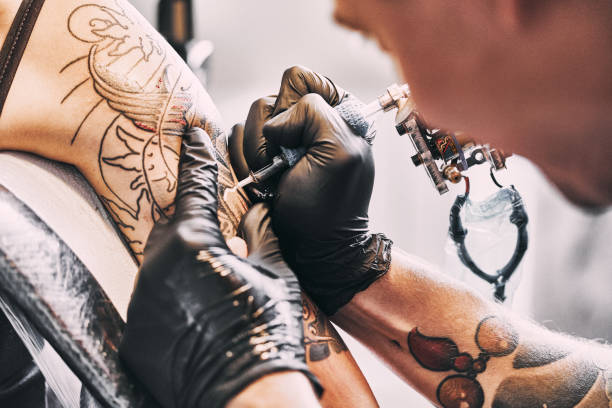Modern Tattoo Removal Technologies Available in Germany
Tattoo removal is a process that may help individuals in Germany achieve clearer skin by gradually fading unwanted ink. Various modern technologies can assist in this journey, with results often varying based on skin type and the characteristics of the tattoo itself. Understanding the methods available ensures informed decisions regarding the removal process.

What are the primary tattoo removal technologies used in Germany?
The tattoo removal landscape in Germany has evolved significantly, with several cutting-edge technologies now at the forefront. The most widely used and effective method is laser tattoo removal. This technique employs high-intensity light beams to break down tattoo pigments, allowing the body’s immune system to naturally remove the ink particles over time. In Germany, clinics typically use Q-switched lasers or picosecond lasers, which are known for their precision and effectiveness.
Another technology gaining traction is intense pulsed light (IPL) therapy. While less common than laser treatments, IPL can be effective for certain types of tattoos, particularly those with lighter colors. Some German clinics also offer combination therapies, which may include laser treatments alongside other methods to enhance results.
How do tattoo removal technologies affect different ink colors and skin types?
Understanding the interaction between tattoo removal technologies and various ink colors is crucial for effective results. Laser treatments, the gold standard in Germany, work by targeting specific pigments. Black and dark blue inks typically respond best to laser removal, as they absorb light across a broad spectrum. However, modern picosecond lasers have improved the ability to target a wider range of colors, including stubborn greens and blues.
Skin type also plays a significant role in the removal process. The Fitzpatrick scale, which classifies skin types based on their reaction to sunlight, is often used to determine the most appropriate treatment approach. For individuals with darker skin tones, practitioners in Germany may opt for longer wavelength lasers to minimize the risk of hyperpigmentation or other side effects.
What factors influence the success of tattoo removal in Germany?
Several factors can impact the outcome of tattoo removal procedures in Germany. The age of the tattoo is a primary consideration; older tattoos often respond better to removal treatments as the ink has already begun to fade naturally. The depth and density of the tattoo ink also play a role, with professional tattoos typically requiring more sessions than amateur ones due to their precise application and higher ink concentration.
The location of the tattoo on the body can affect removal success as well. Areas with good blood circulation, such as the chest or back, tend to show faster results compared to extremities like hands or feet. Additionally, the patient’s overall health and immune system function can influence how quickly the body processes and eliminates the broken-down ink particles.
How many sessions are typically required for complete tattoo removal?
The number of sessions required for complete tattoo removal in Germany can vary significantly depending on individual circumstances. On average, patients can expect to undergo 6 to 12 treatment sessions, spaced 6 to 8 weeks apart. This timeline allows the skin to heal between treatments and gives the body time to process the fragmented ink particles.
It’s important to note that complete removal is not always guaranteed, and some tattoos may leave a faint shadow or require additional touch-up sessions. German clinics often emphasize realistic expectations and provide personalized treatment plans based on the specific characteristics of each tattoo and the patient’s goals.
What are the potential side effects and aftercare considerations?
While tattoo removal technologies in Germany are generally safe when performed by qualified professionals, there are potential side effects to consider. Immediately after treatment, patients may experience redness, swelling, and a sensation similar to a mild sunburn. These effects typically subside within a few days.
More serious but less common side effects can include blistering, changes in skin texture, or scarring. To minimize risks and promote optimal healing, German clinics provide detailed aftercare instructions. These often include keeping the treated area clean and dry, avoiding sun exposure, and applying recommended ointments or dressings.
What are the cost considerations for tattoo removal in Germany?
The cost of tattoo removal in Germany can vary widely depending on factors such as the size and complexity of the tattoo, the type of technology used, and the number of sessions required. On average, patients can expect to pay between €150 to €400 per session for laser tattoo removal. For a complete treatment course, total costs may range from €900 to €4,800 or more.
| Treatment Type | Average Cost Per Session | Estimated Total Cost (6-12 sessions) |
|---|---|---|
| Q-switched Laser | €150 - €300 | €900 - €3,600 |
| Picosecond Laser | €200 - €400 | €1,200 - €4,800 |
| IPL Therapy | €100 - €250 | €600 - €3,000 |
Prices, rates, or cost estimates mentioned in this article are based on the latest available information but may change over time. Independent research is advised before making financial decisions.
Tattoo removal in Germany offers a range of advanced technologies to suit various needs and tattoo types. While the process can be time-consuming and potentially costly, many individuals find the results worthwhile. As technologies continue to evolve, the effectiveness and efficiency of tattoo removal procedures are likely to improve further, providing even better options for those seeking to modify or remove their body art.




